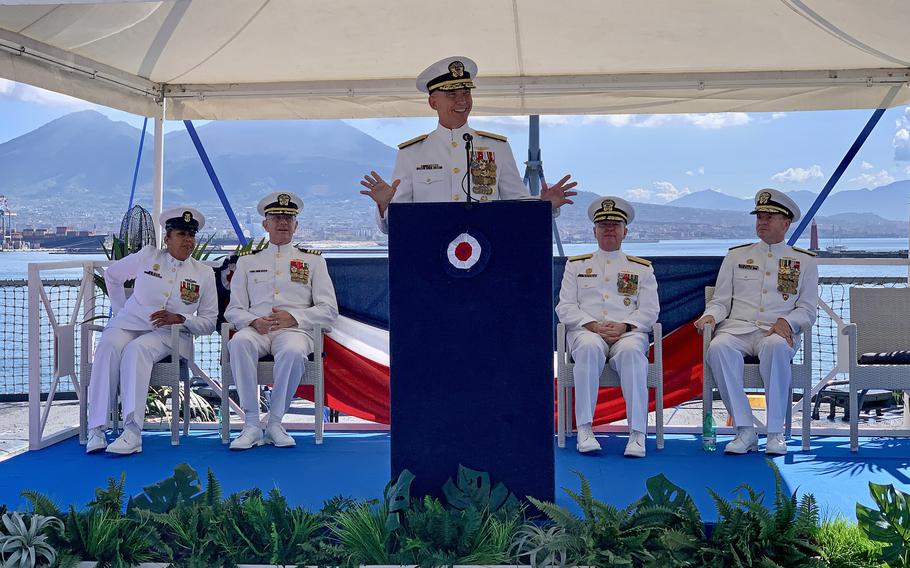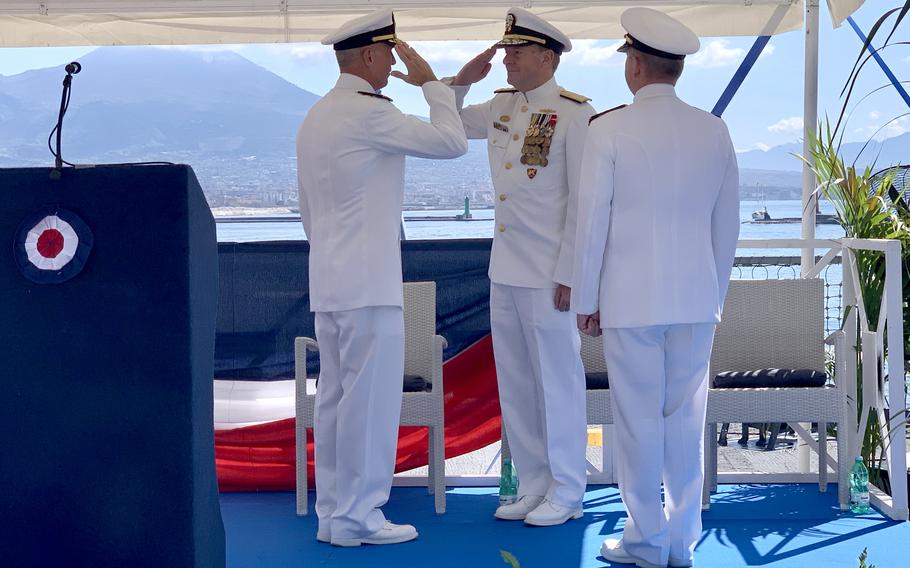
Vice Adm. Thomas Ishee, former commander of U.S. 6th Fleet, left, stands next to Vice Adm. Jeffrey Anderson, commander of 6th Fleet, center, following a change of command ceremony aboard the amphibious command ship USS Mount Whitney in Naples, Italy, on Sept. 20, 2024. (Alison Bath/Stars and Stripes)
NAPLES, Italy — The increasing risk of widespread war in the Middle East and continued Russian aggression in Europe are some of the biggest challenges facing the Navy in the region, one of the service’s top officers said as he bid farewell to command of the U.S. 6th Fleet.
Recent exploding pager and walkie-talkie attacks on Hezbollah militants in Lebanon that killed dozens and injured thousands, and the terrorist group’s promise of retaliation against Israel have created the very real potential for serious miscalculation, Vice Adm. Thomas Ishee said Friday.
“This could very easily become a case where there’s an escalation and then Israel decides to escalate back, and now we’re on the way to a broader war,” Ishee said. “That’s my fear.”
Ishee said he believes that neither Hezbollah nor Israel wants to see a larger conflict, “but they also both have their own objectives that keep them shooting at each other, and there could easily be a mistake like the missile from Hezbollah that hit the soccer field” in July, killing 12 Israeli children.

Vice Adm. Jeffrey Anderson speaks during a ceremony on Sept. 20, 2024. Anderson assumed command of U.S. 6th Fleet, Naval Striking and Support Forces NATO and Joint Force Maritime Component Commander Europe during a ceremony aboard the amphibious command ship USS Mount Whitney in Naples, Italy. (Alison Bath/Stars and Stripes)
The potential for error also exists in Europe, where Russia is “scratching on the edges, in the gray zone” of provoking wider war, said Ishee, noting that mistakes have previously caused wars on the Continent.
A strong U.S. commitment to NATO along with continued demonstration of the alliance’s capabilities and unity are needed to keep Moscow in check, he said.
“Hopefully, Russia will see that and think today is not a great day to attack NATO,” said Ishee, adding that he doesn’t think the Kremlin wants a wider war.

Vice Adm. Thomas Ishee is saluted by sailors as he departs a change of command ceremony aboard the USS Mount Whitney in Naples, Italy, on Sept. 24, 2022. Ishee, who served as commander of U.S. 6th Fleet, Naval Striking and Support Forces NATO and Joint Force Maritime Component Commander Europe since September 2022, will retire. (Alison Bath/Stars and Stripes)
Ishee made the remarks after relinquishing command of 6th Fleet, Naval Striking and Support Forces NATO and Joint Force Maritime Component Commander Europe to Vice Adm. Jeffrey Anderson in a ceremony aboard the amphibious command ship USS Mount Whitney in Naples.
Adm. Stuart Munsch, commander of U.S. Naval Forces Europe-Africa and Allied Joint Forces Command, Naples, presided over the handover that made Anderson the 50th commander of 6th Fleet.
A 1991 U.S. Naval Academy graduate, Anderson has served in numerous squadrons flying F/A-18 Super Hornet fighter jets and has deployed in support of operations Deliberate Forge, Southern Watch, Enduring Freedom, Iraqi Freedom and Inherent Resolve, according to his Navy biography.
Those deployments have found the Fayetteville, Ga., native embarked on the aircraft carriers USS Enterprise, USS Dwight D. Eisenhower, USS Theodore Roosevelt and USS Harry S. Truman.

Vice Adm. Jeffrey Anderson, left, salutes Adm. Stuart Munsch, commander of U.S. Naval Forces Europe-Africa and Allied Joint Forces Command, Naples, during a change of command ceremony aboard the USS Mount Whitney in Naples, Italy, on Sept. 20, 2024. (Alison Bath/Stars and Stripes)
More recently, Anderson has served as the Navy’s deputy director for political and military affairs in Asia, as commander of Carrier Strike Group 3 embarked on the aircraft carrier USS Abraham Lincoln and as director for operations of U.S. Indo-Pacific Command, according to the Navy.
As the second-highest-ranking Navy officer in Europe, Ishee led U.S. 6th Fleet during a reemergence of Cold War-like sensibilities in the aftermath of Russia’s 2022 attack on Ukraine, as well as the security threats following Hamas’ deadly attack in Israel last year.
Munsch praised Ishee for his leadership during Navy operations in the eastern Mediterranean Sea aimed at deterring Iran and its proxies in Lebanon and Yemen from provoking a wider war. Ishee also directed the service’s response to humanitarian crises in Turkey and Gaza.
Those events have seen the fleet shift its focus from exercises with allies and partners to a world where “we’re preparing our ships to go into places where they would get shot at,” Ishee said.
“We continue to operate today between two raging conflicts in the theater and a significant threat to freedom of navigation in the Red Sea,” said Ishee, who plans to retire.